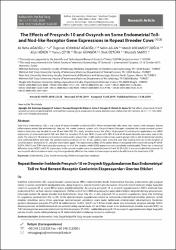The Effects of Presynch-10 and Ovsynch on Some Endometrial Toll- and Nod-like Receptor Gene Expressions in Repeat Breeder Cows

Göster/
Tarih
2020Yazar
Ağaoğlu, Ali RehaAdaoğlu, Özgecan Korkmaz
Aslan, Selim
Kocamüftüoğlu, Mesih
Köker, Afşin
Çetin, Yunus
Saatçi, Mustafa
Üst veri
Tüm öğe kaydını gösterÖzet
Subclinical endometritis (SE) is one cause of repeat breeder syndrome (RBS). When endometrial cells come into contact with antigens during inflammatory events like endometritis, they act like innate immune system cells. Ovsynch-based therapies stimulate the innate immune system, which is how they may be able to cure SE and then RBS. This study aimed to assess the effects of presynch-10 and ovsynch applications on mRNA expressions of some endometrial Toll- and Nod-like receptors (TLRs and NLRB) in cows with RBS. A total of 40 repeat breeder cows were used in the study. The presynch-10 and ovsynch protocols were used in group 1 (G1, n=20), and no protocol was used in group 2 (G2, n=20). Endometrial samples were collected before and after the synchronization protocols in G1. In G2, samples were collected, and after waiting time up to the duration of synchronization protocol in G1, samples were taken again. The expression profiles of the genes being investigated were examined using RT-qPCR. NLRC4, NALP3 and TLR4 were basically expressed in all of the samples while NOD2 expression was completely undetectable. There was a statistical difference when NOD1 and TLR2 expressions in the second samples were compared between G1 and G2 (P<0.05). It was concluded that presynch-10 and ovsynch administration in cows may have a positively effect on the innate immune response and so be effective in the treatment of SE.

















